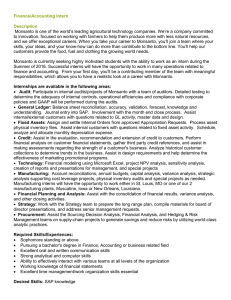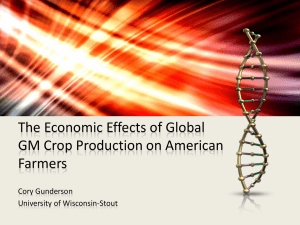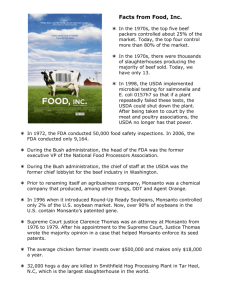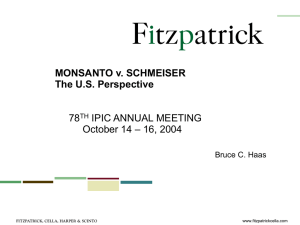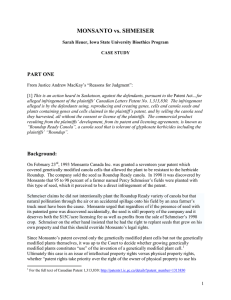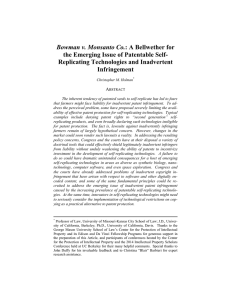gene patents and farmers: bane or boon?
advertisement
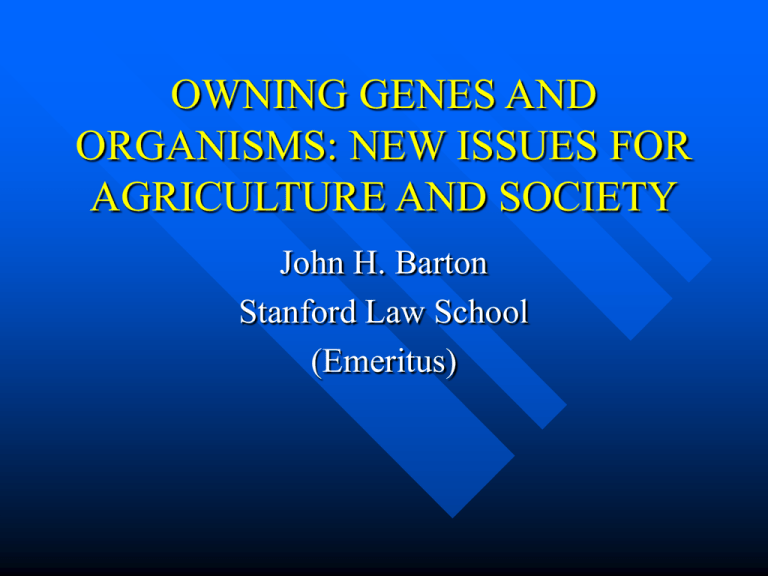
OWNING GENES AND ORGANISMS: NEW ISSUES FOR AGRICULTURE AND SOCIETY John H. Barton Stanford Law School (Emeritus) OUTLINE PATENTS AND CROPS WHAT THEY HAVE DONE TO THE INDUSTRY WHAT THEY’VE DONE TO THE FARMER WHAT THEY’VE DONE INTERNATIONALLY EVALUATION WHAT ARE THE CROPS? Bt-based insect resistance – Corn – Cotton Herbicide resistance – – – – Canola Corn Cotton Soybeans Pictures from USDA & Monsanto, courtesy of http://cls.casa.colostate.edu/TransgenicCrops/current.html HOW DO YOU PATENT A GENE? Possible claims on: – The isolated gene – Constructs containing it (that are used to transform plants) – Transformed cells – Transformed plants – Seeds of transformed plants – Methods of transforming plant or of producing the crop through use of the gene inserted into the crop – Specific crop lines (JEM v. Pioneer (2001)) WHAT ELSE IS PATENTED? Promoters Recoding processes Transformation processes A SENSE OF NUMBERS Annual applications for cell and tissue culture: ~ 24 For vectors etc: ~ 64 For traits: ~ 80 For germplasm: ~ 180 (2001 numbers, from Aurigin Systems/MicroPatent, presented in Boettinger et al 2004) IMPACT ON THE INDUSTRY The seed industry in the 1960s and 70s: – Small and middle-sized entities (Pioneer, DeKalb, etc.) – Substantial role for land grant universities Today – Vertically and horizontally integrated (Monsanto, Syngenta, DuPont, Bayer, Dow) – For Bt corn, Pioneer/DuPont has ~ 50%, Monsanto ~ 20%, Syngenta ~ 30% (Benbrook 2002) – Monsanto technology in 59-97% of GMO seed market (2004 numbers ETC group 2005) – Much less role for land grant universities REASONS FOR INTEGRATION Vertical integration – Marketing – Production Horizontal integration – Covering research costs – Settling patent disputes Implication -- ?? --decreased expenditures on R & D! (decline reflects market as well as concentration) THE PATENT FACTOR - I Litigation: early & mid 1990s: at least 21 cases among: – – – – – – – Agracetus Boehringer Calgene Ciba-Geigy DeKalb DNAP Ecogen Enzo Mycogen Monsanto Novartis PGS Pioneer Over transformation, vectors, Bt etc. THE PATENT FACTOR II These companies are now: – Agracetus => – – – – – Boehringer Calgene => Ciba-Geigy => DeKalb => DNAP => – Ecogen => Monsanto Monsanto Syngenta Monsanto Different business Mitsui Enzo => Different business Mycogen => Dow Monsanto Novartis => Syngenta PGS => Bayer Pioneer => DuPont THE PATENT FACTOR III And the 2004-05 litigation includes: – Monsanto v. Bayer (Bt gene) – Syngenta v. Monsanto & others (coding sequences) (2005 jury decision, now on appeal) (Also 2004 cross license to settle other Syngenta-Monsanto patent disputes)(and 2006 Syngenta-DuPont joint venture) – Mycogen v. Monsanto (gene modification) PATENTS AND FARMERS http://cls.casa.colostate.edu/TransgenicCrops/current.html h t Commercialization really began in 1996. SUMMARY OF STUDIES: HERBICIDE TOLERANCE Yield – 5 increase – 2 small increase – 5 same Pesticide use – 4 decrease – 1 small increase Returns – 5 increase – 4 same SUMMARY OF STUDIES: BT Yield – 13 increase – 1 same Pesticide use – 7 decrease Return – 7 increase – 2 decrease – 2 depends on infestation (compiled from Fernandez-Cornejo & Caswell, ERS 2006) STACKED MARKETING RESTRICTIONS The patent The PVP right The technology agreement The seed label Biological protection – Hybrid – Terminator gene (“GURT”) THE TECHNOLOGY AGREEMENT Prohibition of – Reuse of harvested seed – Research on seed – Use of competing herbicides/failure to respect resistance management – Not respecting channeling Forum selection clause/choice of law/arbitration Authorization for inspections Warranty limitations & liquidated damages clause STANDARD LITIGATION Farmer reuses seed => Industry investigation & suit Defenses: – Patent doesn’t reach reuse of seed – Contract/use of patent violates antitrust law – These defenses rejected under Monsanto v. McFarling (CAFC 2004) Usual decision is for seed company save on minor points. At least 90 such suits as of 2003. PERCY SCHMEISER: AT TRIAL Defense was that the seed/pollen blew across fence in 1996. Factual basis of this was at issue in trial court. That court (Saskatoon) held that farmer infringed patent when, knowing that it was resistant, he retained seed and used in in 1998. Thus, this case is not the example of inadvertent infringement that it is often held to be. SCHMEISER ON APPEAL Five-to four majority of Canada Supreme Court held for Schmeiser on narrow grounds: Monsanto had asked for profits and Court held that there were no profits beyond those with regular seed – had Monsanto asked for royalties, result might have been different Minority held that the patent was being applied to cover the entire plant, something not possible under Canadian law. INTERNATIONAL ISSUES Europe – concern about GMOs (and serious efforts to prevent developing nations from using the technology) Developing countries – concerns about access to technology, genetic resources EUROPEAN ISSUES Opposition to GMOs (food attitudes, different regulatory experience, precautionary principle) => – Efforts to restrict applicability of patent law, based on intervention through European Parliament (1998)(fundamentally unsuccessful) – Efforts to bar imports: » De facto EU moratorium 1998 => 2003 » National moratoria – Effective results are » Labeling and » Dual price system (2.5 to 15 % premium for non-GMO; 6 to 17 % cost of segregation (EU DG Ag 2000) THE WTO CASE Brought by US and Canada against EU on basis of moratoria WTO (interim decision) resolved case on basis of Sanitary and Phytosanitary Code (1995): Two issues – EU moratorium » Violated Annex C(1)(a) – dealing with undue delay » But not inconsistent with Article 5.1 requiring a risk assessment, nor had US established that EU violated Article 2.2 on need for scientific basis for conclusions – Maintenance of member state prohibitions on particular specific products » EU acted inconsistently with Articles 5.1 and 2.2 DEVELOPING COUNTRY ISSUES – GENETIC RESOURCES Starting with PVP revisions (1980), concern about genetic resources; – Farmer’s rights – Resentment at possible IP costs Agreement efforts – – – – FAO Commission; International undertaking (1983) Convention on Biodiversity (1992) FAO/CGIAR (1994) International Treaty on Plant Genetic Resources (2001) Access now difficult DEVELOPING COUNTRY ISSUES – GLOBAL PATENT LAW PRESSURE TRIPS – 1995 – Duty to protect plants through PVP or patents Concerns – Exchange among poor farmers – Farmer reuse of seeds – Structure of seed industry CGIAR and difficulty of research (research tool issue, more severe than in medicine, but effect in developing world often overstated) DEVELOPING COUNTRY ISSUES -- ADOPTION Adoption by market mechanism – Argentina & Monsanto – India & Mayhco & Monsanto Adoption by smuggling – Brazil Adoption by public sector research – China Counterforces – NGO opposition to CGIAR research and in India – Concern about export markets to Europe GLOBAL ADOPTION EVALUATION Hard to separate patent issues from biosafety and political aspects of GMOs Moreover, much anti-GMO and anticorporate thinking included in the critiques of patents SUCCESSES OF PATENTS Almost certainly increased the private investment in research on introducing GMO crops And these crops have been a success for farmers in US, Canada, Argentina Some possibility of the mechanism working in Brazil, China, and India COSTS OF PATENTS Significant contribution to industry concentration, with probable negative impact on farmer/industry division of rents, and on level of research. Significant complications for land grant universities. Significant disruption of international research access to agricultural genetic resources MIGHT WE HAVE DONE BETTER? Patent office misjudgments? Antitrust and the industry mergers? Reuse of patented seeds? Research on patented seeds? Industry errors on biosafety? THANK YOU jbarton@stanford.edu
